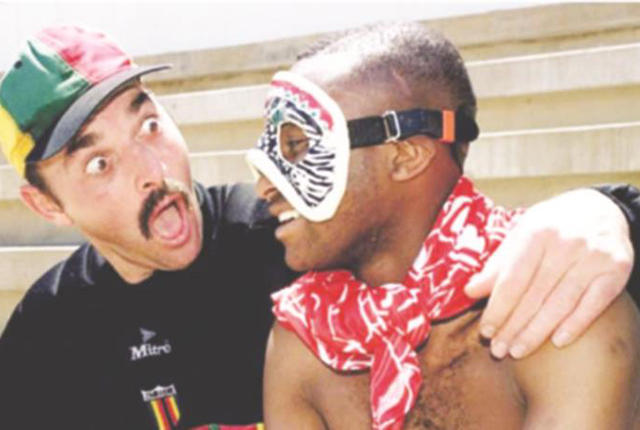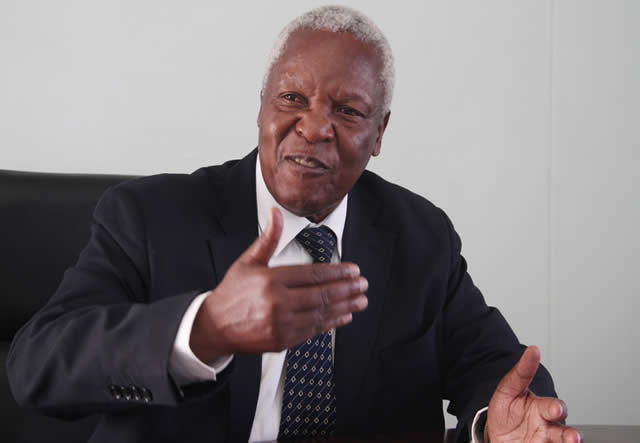Bringing back the feel good factor to our football


Bruce Grobbelaar and Peter Ndlovu having fun during the days of the Dream Team that was under the guidance of Reinhard Fabisch
David Mungoshi Shelling the Nuts—
SPORT can be a very useful tool for bonding and for gelling. The ancient Greeks knew this very well. That was why, in the city state of Sparta, physical conditioning and endurance were of utmost importance.That also is the reason we still have the Olympic Games, an idea taken from ancient Greece.
During the Olympics, all hostilities between states were suspended as play, glee, camaraderie and healthy competition reigned supreme.
My son, a keen rugby player in his time at secondary school, once told me that when a rugby team is psyched up and has done its war cries they move and think like one organism, believing everything.
He said in that state if the team is told to go through a wall they might just do that. His remarks made something clearer in my mind: what sport can do.
Before 1980 “African” schools had a limited sports curriculum.
Girls played netball while the boys played football and everybody did athletics.
In the “European” schools, rugby was a must for the boys. Rugby was a sport for developing esprit de corps.
According to the online Merrian-Webster’s Learner’s Dictionary, “esprit de corps” is “the common spirit existing in the members of a group and inspiring enthusiasm, devotion and a strong regard for the honour of the group.”
Since the European school was a microcosm of white Rhodesian society, sports like rugby were used to inculcate colonial ideology.
Technically, every white boy was groomed for leadership of the black masses. When later they were called up to fight a bush war against “communist terrorists” bent on destroying Rhodesia’s Christian civilisation, the white boys were, by then, veterans in the arena of team work and discipline.
They could take orders without flinching. What is interesting and instructive in all this is the fact that contrary to what many may think, white Rhodesians were not ethnically homogeneous.
Of course they never referred to themselves as tribes, preferring to reserve that categorisation for the Africans.
This was despite the fact that white Rhodesia comprised Afrikaners, Italians, Greeks, Portuguese, Scots and English.
When it came to dealing with the black populace they presented a common front, that of a master race in charge. This was what the horse and rider philosophy of Roy Wellensky’s Federation of Rhodesia and Nyasaland was all about.
The military ethos among white boys began at primary school where they became cadets and wore a special uniform to mark them out. The drills they engaged in were quasi-military. Juxtaposed with rugby would be what might be called gentlemen’s games: cricket, tennis, hockey and of course lots of swimming!
On leaving school some played football in white teams like Salisbury Callies and Bulawayo Rovers.
In the end though, the numbers of white players in football kept tapering off until there were none to continue the tradition after the likes of Topsy Robertson, John “Seke Mutema” Humphreys, Graham Boyle, Bruce Grobbelaar, Billy Sharman, Tommy Ballantyne, Rob Jordan, Brian Pearce and several others.
Football can be a festive experience with no fears of post-match violence between the players. It can also be used to heal and glue society. Therefore, competition should be healthy and friendly with no animosity or antagonism.
Let the stadiums resound with banter and rival songs but all as part of the recipe for collective joy and entertainment.
This is what used to happen in the schools and was sometimes carried over into the wider world outside the school yard.
The rivalry did not spill from the stadium to places of residence.
We can bring back the feel-good factor into our football by using imagination. In the olden days public holidays had lots of fanfare with Salisbury City’s Yellow Peril travelling to play Bulawayo City’s Red Army.
Great football was played and the likes of Obadiah Sarupinda, Tamburike and Dusty King Gotora on display. At one time Gotora was said to be the best number 8 on the continent!
Football was good and it was fun. We need to bring that back. But spoil-sports like that anachronistic Highlanders fan who celebrated a well-deserved and famous victory by Highlanders over Dynamos at Barbourfields with a toxic placard directed at “Mashona Dogs” can make that difficult to achieve.
Sportsmanship dictates that you appreciate the rival team because without them your team would have nowhere to exhibit its excellence.
Boxers are a very good example of how to do that. At the end of a bout they hug and boxing wins.
That fan needs to be banned until he can guarantee good behaviour.
He gives football a bad name.
A glance at Zimbabwe’s football across the years can be quite instructive. Before the advent of Mashonaland United there was a club known as Mashonaland Football Club.
This club together with Matabeleland Highlanders and a team called North Rhodesia were the main teams in the City of Bulawayo and week after week they entertained the crowds to pulsating soccer.
Anyone could play for any team they chose to play for without fear of being ostracised by anyone. Memo Khumalo played centre forward for Mashonaland FC and that was never an issue.
Highlanders too had its own non-Ndebele players even way back then.
Gibson Makanda was one such player.
And what a prolific number 9 he was!
It was beautiful at half-time to see small boys rushing onto the pitch (there were no fences then) with their tennis balls.
Once there they took on new names, depending on what player was doing well on the day, and went to great lengths to imitate that player’s skills. Role modelling at its most basic!
The Dream Team under Reinhard Fabisch effortlessly packed the stadiums and became everyone’s number one team.
Songs were composed and recorded in the team’s honour by Tanga WekwaSando and by Cephas Mashakada and the Muddy Face Band.
But perhaps of all the soccer-based songs, the album by Zexie Manatsa and the Green Arrows has been the most enduring. Songs from “Tsuro Soccer Star” are still being played after soccer matches on radio, as is Lovemore Majaivana’s “Tshilamoya”.
Manatsa’s album has songs for Highlanders, Zimbabwe Saints, Caps United and Dynamos and brings back the nostalgia with its eulogies of Lucky Dube, the goalkeeper, Moses Chunga and many others.
I think the soccer teams should reciprocate with royalties to Manatsa. That would certainly not be new or unusual. When Liverpool fans sing, ‘You’ll never walk alone’ they extol Gerry and the Pacemakers, Liverpool lads who did that song. That must be worth something for Gerry and his mates if they are still around.
Let us celebrate Knowledge Musona, Khama Billiat and others with fan clubs and other activities. Endorsements can soon follow. Football can create a national feel-good factor with a possible trickle-down effect. Come on people, bring back the good times! Bring back the football convoys, the fun and the camaraderie.
The late wrestler, Maxwell Kutsanzira, a colourful and staunch Zimbabwe Saints fan, was a regular traveller to the team’s away games.
With his beard and shaven head, his stage presence made others follow the game.
The Mighty Warriors need our greatest appreciation. They made history by qualifying for the Rio de Janeiro Olympics against all odds. We embraced them then and must continue to do so. Their qualification was nothing short of heroic. During the Olympic extravaganza, they showed great heart and even scored a spectacular goal against a mightier team. Surely it’s time for a women’s football league to give the girls regular playing time and turn them into professionals. Let us all come to the party: fans, government and the corporate world!
For their part, clubs must do everything they can to make sure that none of their fans do anything to spoil their brand and give them a bad name. Initiative and enterprise will do the trick: the sale of club regalia and other business models including websites and club magazines.
Kaizer Chiefs of South Africa are a business entity and even run a funeral cover scheme! Twinning with Chiefs could prove to be more than useful for whichever club makes the leap. Clubs can negotiate deals with the corporate world to enable them to grow better and bigger. They must grow, keep their fan base and enhance their brand. Club houses, stadiums and proper accounting are a must in the modern game and teams like Highlanders and Dynamos must wake up.
Imagine what they could achieve if each of their fans contributed just a dollar each month. ‘Seven million’ Dynamos fans would mean seven million dollars monthly and Dynamos would become a mega club. Look at Real Madrid. Spain’s GDP is nothing to write home about, but they are the richest club in the world! The good times could start rolling.
David Mungoshi, an applied linguist and teacher of long-standing is a published poet and short story writer and award-winning novelist.









Comments